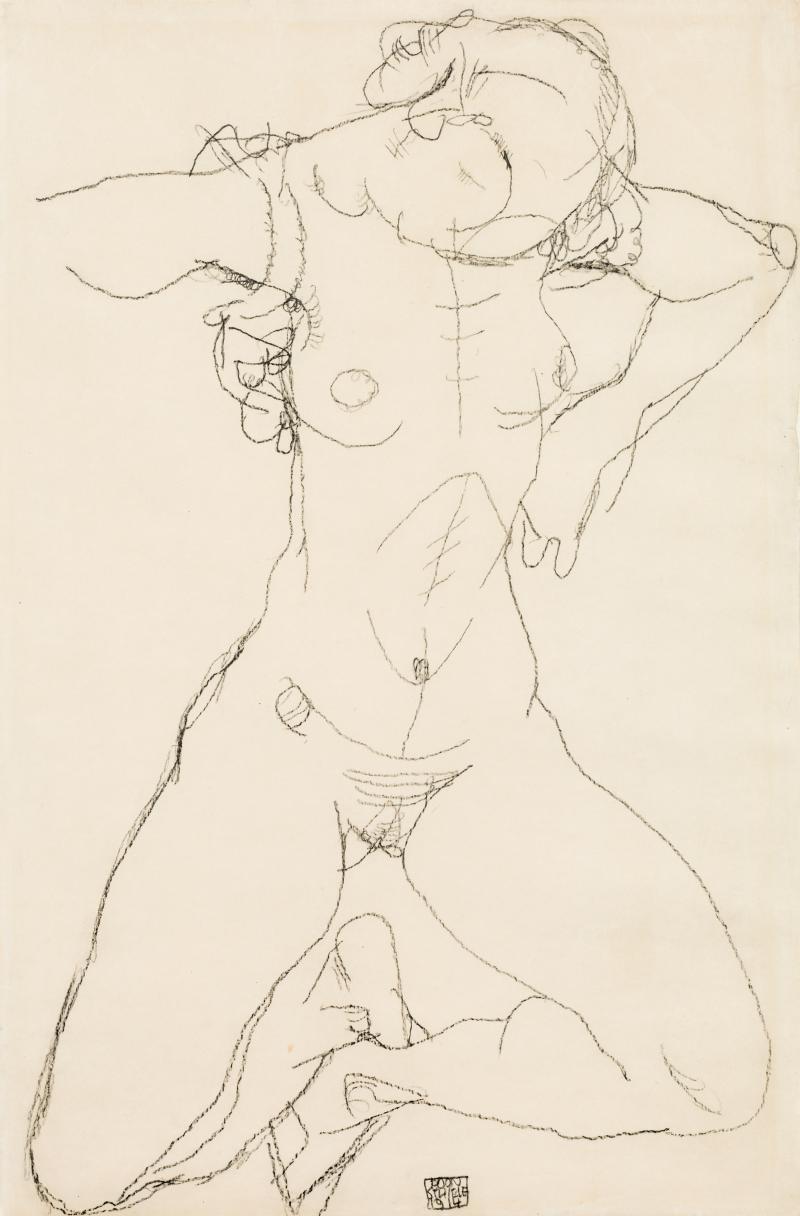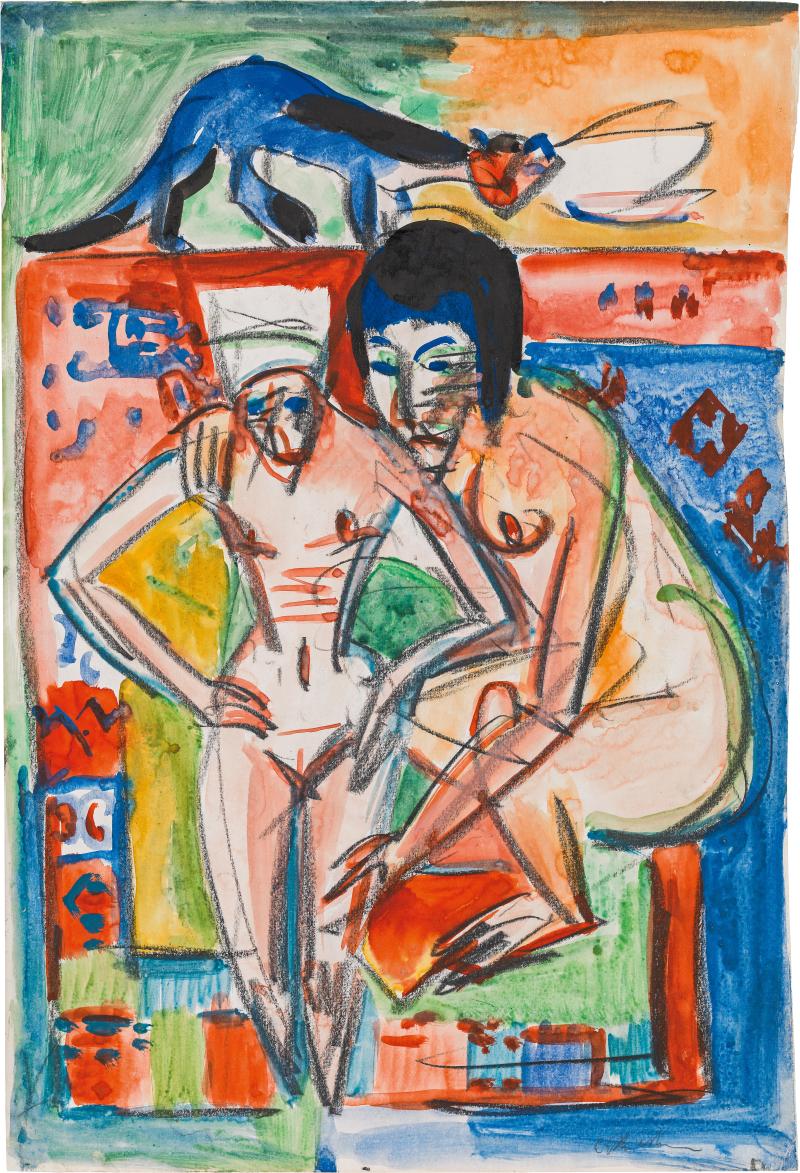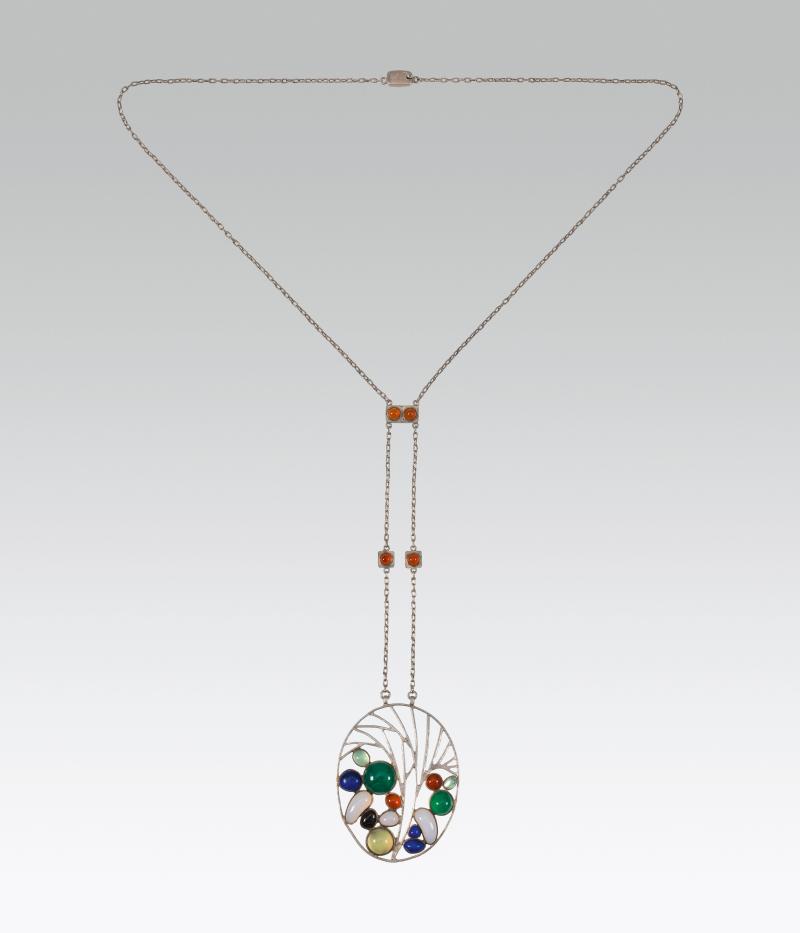Impressionist & Modern ArtWatercolours and paintings by Egon Schiele, Albin Egger-Lienz, Rudolf Wacker, Franz Sedlacek, along with fine examples from the oeuvres of Umberto Boccioni, Erich Heckel, Otto Mueller, Gabriele Münter and Anton Birkle are a feature of the upcoming autumn auction of Impressionist & Modern Art at im Kinsky. Expressive drawings such as a female nude by Schiele, a sitting girl by Heckel and the rare subject of five nudes by Mueller from 1910 are contrasted with highly charged still lifes by Rudolf Wacker and Franz Sedlacek and deeply heartfelt paintings of the Madonna by Egger-Lienz and Josef Floch. Also worthy of attention is a very interesting watercolour by Ernst Ludwig Kirchner, which uses very coded iconography in its presentation of two female nudes with a cat. It was painted in the 1920s during his years in Davos where the artist experimented with solid areas of paint while retaining his powerful colours.Alfons Walde is once again represented by a painting of outstanding quality titled Bauernsonntag: an allegory of power, closeness to nature and country life encapsulated in pictorial form.
Art Nouveau & DesignThe jewellery created by the Wiener Werkstätte has always been legendary for creating timeless combinations of luxurious, very often intensely coloured materials, and subtly designed, ornamental, architectural shapes. Once again, Kinsky is able to present one of the most sought-after pieces of jewellery by Josef Hoffmann. Ottor Prutscher was, like Hoffmann, an architect, designer and sensitive craftsman. His glasses are also uniquely elegant and are highly valued by collectors. In autumn, an entire set of liqueur glasses are coming to auction.
Mosaic has been in use for thousands of years and went through a renaissance in 1900 with the Arts and Crafts movement and Wiener Werkstätte. One of the most important artists employing this technique was Leopold Forstner, who opened the first workshop of the Wiener Werkstätte in Vienna in 1906 and produced large numbers of mosaics for churches, such as Otto Wagner Kirche in Steinhof, public buildings, such as Dianabad in Vienna and the frieze by Klimt at the Stoclet Palace, based on works by famous artists but also on his own designs. He was famous for his method of cementing ceramic and glass in mosaics, to produce new colours and light effects. The upcoming auction is presenting numerous items from the artist’s estate, any of which would be exciting additions to any collection of Modern art.
Contemporary ArtThe wide and diverse range presented by this department is again being split into two catalogues to be auctioned in the afternoon and evening.
We are very pleased able to present a selection from the private collection of the charismatic museum director Dieter Ronte! The former director of the Museums of Modern Art in Vienna, Hanover and Bonn was already collecting as a student, and as a prominent speaker at exhibitions and auctions he was always at the cutting edge and always in close contact with artists. The most important masterpiece from the collection is a large painting by Maria Lassnig from 1983: “Herbstbild / Herbst” [Autumn Scene / Autumn], a newly discovered forgotten work and a significant addition to her important body of work. The diverse nature of the collector’s interests is reflected in works acquired from Christo, Joseph Beuys, Günther Uecker, Markus Lüpertz, and the Austrian painters Max Weiler, Oswald Oberhuber and Gugging Artists.
There is an embarrassment of riches at im Kinsky with another painting by Maria Lassnig from 1994, a three-part, eloquent sequence of paintings of Lassnig’s forms. Some other highlights of the auction are two important works by Max Weiler, along with watercolours and sketches from various periods of his work. Durchblick durch blaue Gegend [View of Blue Surroundings] from 1975 and Blaue Bäume und Purpurhimmel [Blue Trees and a Purple Sky] from 1973, are exceptional masterpieces that display Weiler’s advanced understanding of colour and impressively document his vision of landscape.
The international importance of Austrian sculpture is emphasised by works by Fritz Wotruba and a large sphinx by his student Josef Pillhofer. We are presenting works by two of the main exponents of Italian Arte Povera, Jannis Kounellis and Mario Merz, works from the very sought-after series, “Alphabets” and a large work on canvas from the 1980s. The most important Austrian exponent of reduced painting and member of ZERO, Hans Bischoffshausen, is represented by the almost mythical, dark “Materialschlacht” [war of attrition] and numerous works on paper.
 Alfons Walde * (Oberndorf 1891 - 1958 Kitzbühel) 'Bauernsonntag', ca. 1930 oil on canvas; 71.5 × 62.5 cm signed (lower left): A. Walde inscribed by the artist on the reverse on original label: "Bauernsonntag" Original frame acquired directly from the artist; since then in Austrian private property The work is registered in the archive Alfons Walde under the number D-Fl-217. Confirmation of authenticity by Peter Konzert, Innsbruck, 07. 04. 2016, is enclosed. estimate
€ 250,000 - 500,000 - Mit freundlicher Genehmigung von: imkinsky
Alfons Walde * (Oberndorf 1891 - 1958 Kitzbühel) 'Bauernsonntag', ca. 1930 oil on canvas; 71.5 × 62.5 cm signed (lower left): A. Walde inscribed by the artist on the reverse on original label: "Bauernsonntag" Original frame acquired directly from the artist; since then in Austrian private property The work is registered in the archive Alfons Walde under the number D-Fl-217. Confirmation of authenticity by Peter Konzert, Innsbruck, 07. 04. 2016, is enclosed. estimate
€ 250,000 - 500,000 - Mit freundlicher Genehmigung von: imkinsky
 Max Weiler * (Absam bei Hall i. Tirol 1910 - 2001 Wien) "Durchblick durch blaue Gegend" (A view through blue surroundings), 1975 egg tempera on canvas; framed; 105 × 130,5 cm signed and dated on the lower right: Weiler 1975 signed and dated on reverse canvas titled on the reverse of the frame: Durchblick durch blaue Gegend private property, Austria 1991 Prag, Nationalgalerie; 1992 Alpbach, Österreichisches College Otto Breicha, Weiler. Die innere Figur, Galerie Welz Salzburg, Vienna 1989, ill. - Mit freundlicher Genehmigung von: imkinsky /
Max Weiler * (Absam bei Hall i. Tirol 1910 - 2001 Wien) "Durchblick durch blaue Gegend" (A view through blue surroundings), 1975 egg tempera on canvas; framed; 105 × 130,5 cm signed and dated on the lower right: Weiler 1975 signed and dated on reverse canvas titled on the reverse of the frame: Durchblick durch blaue Gegend private property, Austria 1991 Prag, Nationalgalerie; 1992 Alpbach, Österreichisches College Otto Breicha, Weiler. Die innere Figur, Galerie Welz Salzburg, Vienna 1989, ill. - Mit freundlicher Genehmigung von: imkinsky /  Egon Schiele (Tulln 1890 - 1918 Wien) Female nude, 1914 pencil on paper; 48 × 31.7 cm signed and dated (lower center): Egon Schiele 1914 Kornfeld & Klipstein, Bern (1957-1958); private collection, Switzerland; Christie's London, 10. 12. 1997, lot 280; Sotheby's London, 25. 06. 2002, lot 162; private property Vienna; im Kinsky Vienna, 11. 10. 2005, No. 174; European private collection Jane Kallir, Egon Schiele. The Complete Works, New York 1990, Cat.- No. D. 1557, ill. p. 529 estimate
€ 180,000 - Mit freundlicher Genehmigung von: imkinsky /
Egon Schiele (Tulln 1890 - 1918 Wien) Female nude, 1914 pencil on paper; 48 × 31.7 cm signed and dated (lower center): Egon Schiele 1914 Kornfeld & Klipstein, Bern (1957-1958); private collection, Switzerland; Christie's London, 10. 12. 1997, lot 280; Sotheby's London, 25. 06. 2002, lot 162; private property Vienna; im Kinsky Vienna, 11. 10. 2005, No. 174; European private collection Jane Kallir, Egon Schiele. The Complete Works, New York 1990, Cat.- No. D. 1557, ill. p. 529 estimate
€ 180,000 - Mit freundlicher Genehmigung von: imkinsky /  Ernst Ludwig Kirchner (Aschaffenburg 1880-1938 Frauenkirch bei Davos) 'Nackte Frau und Mädchen' (probably Anna Müller), ca. 1925 watercolor and chalk on paper; 49.8 × 33.9 cm estate stamp on reverse with the number: A Da/Bg 6 title on the reverse: Nackte Frau und Mädchen signed (lower right): E L Kirchner from the estate of the artist; Austrian private property This work has been registered at the Ernst Ludwig Kirchner Archive Wichtrach/Bern. estimate
€ 100,000 - 200,000 - Mit freundlicher Genehmigung von: imkinsky /
Ernst Ludwig Kirchner (Aschaffenburg 1880-1938 Frauenkirch bei Davos) 'Nackte Frau und Mädchen' (probably Anna Müller), ca. 1925 watercolor and chalk on paper; 49.8 × 33.9 cm estate stamp on reverse with the number: A Da/Bg 6 title on the reverse: Nackte Frau und Mädchen signed (lower right): E L Kirchner from the estate of the artist; Austrian private property This work has been registered at the Ernst Ludwig Kirchner Archive Wichtrach/Bern. estimate
€ 100,000 - 200,000 - Mit freundlicher Genehmigung von: imkinsky /  Josef Hoffmann (Pirnitz 1870 - 1956 Wien) Medallion with chain Wiener Werkstätte, 1903 silver, gemstones; marked; l. 38 cm; 5 × 4 cm (medallion) private property, Salzburg Wiener-Werkstätte-Archiv, MAK Wien, model no. N 132, design drawing KI 12140-7 estimate
€ 150,000 - 300,000 - Mit freundlicher Genehmigung von: imkinsky /
Josef Hoffmann (Pirnitz 1870 - 1956 Wien) Medallion with chain Wiener Werkstätte, 1903 silver, gemstones; marked; l. 38 cm; 5 × 4 cm (medallion) private property, Salzburg Wiener-Werkstätte-Archiv, MAK Wien, model no. N 132, design drawing KI 12140-7 estimate
€ 150,000 - 300,000 - Mit freundlicher Genehmigung von: imkinsky /